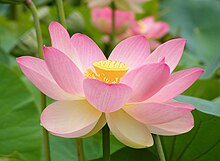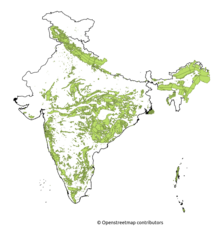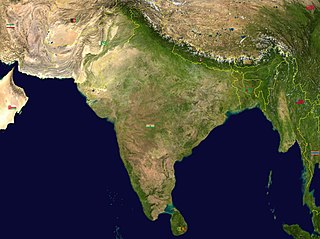
India is situated north of the equator between 8°4' north to 37°6' north latitude and 68°7' east to 97°25' east longitude. It is the seventh-largest country in the world, with a total area of 3,287,263 square kilometres (1,269,219 sq mi). India measures 3,214 km (1,997 mi) from north to south and 2,933 km (1,822 mi) from east to west. It has a land frontier of 15,200 km (9,445 mi) and a coastline of 7,516.6 km (4,671 mi).
The Eastern Ghats is a mountain range that stretches 1,750 km (1,090 mi) along the eastern coast of the Indian peninsula. Covering an area of 75,000 km2 (29,000 sq mi), it traverses the states of Odisha, Telangana, Andhra Pradesh, Karnataka, and Tamil Nadu. The range forms a discontinuous chain of mountains along the eastern edge of the Deccan Plateau, stretching from north of the Mahanadi River in Odisha to Vaigai River in Tamil Nadu at the southern end of the Indian peninsula. The Eastern Ghats meet with the Western Ghats at Nilgiris. The average elevation is around 600 m (2,000 ft) and Arma Konda is the highest peak in the mountains at 1,680 m (5,510 ft).
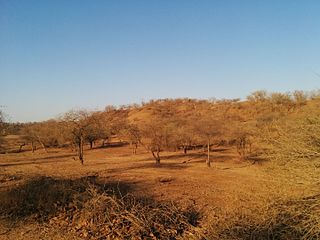
The Khathiar–Gir dry deciduous forests is a mostly arid ecoregion in northwestern India that stretches over 103,100 sq mi (267,000 km2) across Gujarat, Rajasthan and Madhya Pradesh. The dry deciduous forests in the region are dominated by teak, and thorny trees and scrub in drier areas.

An evergreen forest is a forest made up of evergreen trees. They occur across a wide range of climatic zones, and include trees such as conifers and holly in cold climates, eucalyptus, live oak, acacias, magnolia, and banksia in more temperate zones, and rainforest trees in tropical zones.
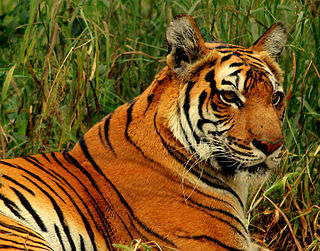
India is the world's 8th most biodiverse region with a 0.46 BioD score on diversity index, 102,718 species of fauna and 23.39% of the nation's geographical area under forest and tree cover in 2020. India encompasses a wide range of biomes: desert, high mountains, highlands, tropical and temperate forests, swamplands, plains, grasslands, areas surrounding rivers, as well as island archipelago. Officially, four out of the 36 Biodiversity Hotspots in the world are present in India: the Himalayas, the Western Ghats, the Indo-Burma and the Nicobar Islands. To these may be added the Sundarbans and the Terrai-Duar Savannah grasslands for their unique foliage and animal species. These hotspots have numerous endemic species. Nearly 5% of India's total area is formally classified under protected areas.

There are four categories of protected areas in India, constituted under the Wildlife Protection Act, 1972. Tiger reserves consist of areas under national parks and wildlife sanctuaries. There are 53 tiger reserves in India. As of January 2023, the protected areas of India cover 173,629.52 square kilometres (67,038.73 sq mi), roughly 5.28% of the total geographical area of the country.

The Eastern Highlands moist deciduous forests, presently known as East Deccan moist deciduous forests, is a tropical and subtropical moist broadleaf forests ecoregion in east-central India. The ecoregion covers an area of 341,100 square kilometers (131,700 sq mi), extending across portions of Andhra Pradesh, Chhattisgarh, Jharkhand, Madhya Pradesh, Maharashtra, Odisha, and Telangana states.

The Northern dry deciduous forests, presently known as the North Deccan dry deciduous forests, is a tropical dry broadleaf forest ecoregion of east-central India.

Namdapha National Park is a 1,985 km2 (766 sq mi) large national park in Arunachal Pradesh of Northeast India. The park was established in 1983. With more than 1,000 floral and about 1,400 faunal species, it is a biodiversity hotspot in the Eastern Himalayas. It harbours the northernmost lowland evergreen rainforests in the world at 27°N latitude. It also harbours extensive dipterocarp forests, comprising the northwestern parts of the Mizoram-Manipur-Kachin rain forests ecoregion.

Andhra Pradesh Forest Department is one of the administrative divisions of Government of Andhra Pradesh. It is headed by the Principal Chief Conservator of Forests, Head of Forest Force. The primary function of this department is protection, conservation and management of forests in the Andhra Pradesh State. The Forest Department is organised into 12 territorial circles and 43 divisions. In addition, one Senior Officer of the rank of Deputy Conservator of Forests functions as Planning and Extension Officer in each district.

The environment of India comprises some of the world's most biodiverse ecozones. The Deccan Traps, Gangetic Plains and the Himalayas are the major geographical features. The country faces different forms of pollution as its major environmental issue and is more vulnerable to the effects of climate change being a developing nation. India has laws protecting the environment and is one of the countries that signed the Convention on Biological Diversity (CBD) treaty. The Ministry of Environment, Forest and Climate Change and each particular state forest departments plan and implement environmental policies throughout the country.
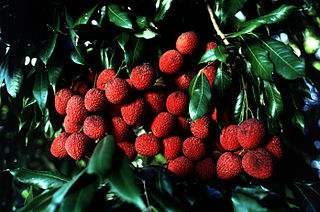
The Indian state of Bihar contains sub-Himalayan foothills and mountains with moist deciduous forests. Rainfall may exceed 1600 millimeters per year. Common trees include Shorea robusta (sal), Toona ciliata, Diospyros melanoxylon (kendu), Boswellia serrata (salai), Terminalia tomentosa (asan), Terminalia bellirica (bahera), Terminalia arjuna (arjun), Pterocarpus marsupium (paisar), Madhuca indica (mahua).

The Sálim Ali Centre for Ornithology and Natural History (SACON) is the South India centre of WII. It is a national centre for information, education and research in ornithology and natural history in India.

Odisha, a state in eastern India, is extremely diverse and gives the state abundance of natural beauty and wildlife. The districts in the interior are thickly covered by tropical moist deciduous and tropical dry deciduous forests. The hills, plateaus and isolated areas of the northeastern part of the state are covered by the tropical moist deciduous forests whereas the dry deciduous forests are located in the southwest region of the state. Some of the trees which grow in abundance in Odisha are bamboo, teak, rosewood, sal, piasal, sanghvan and haldi. There are 479 species of birds, 86 species of mammals, 19 species of amphibians and 110 species of reptiles present in Odisha. The state is also an important habitat for the endangered olive ridley turtles and Irrawaddy dolphins. Koraput district of southern Odisha has been identified by Food and Agriculture Organisation (FAO) of UN as Global Agricultural Heritage site which is among only other three sites in the world. Other sites are in Peru, China and Philippines.

The Western Himalayan subalpine conifer forests is a temperate coniferous forests ecoregion of the middle and upper elevations of the western Middle Himalayas of Nepal, India, and Pakistan.

Tropical evergreen forests of India are found in the Andaman and Nicobar Islands, the Western Ghats, which fringe the Arabian Sea, the coastline of peninsular India, and the greater Assam region in the north-east. Small remnants of semi-evergreen forest are found in Odisha state. Semi-evergreen forest is more extensive than the evergreen formation all over India because evergreen forests tend to degrade to evergreen with human interference. There are substantial differences between the three major evergreen forest regions. The average annual rainfall is 69-79 inches.
Shoolpaneshwar Wildlife Sanctuary is a protected area in India's Gujarat state, located in the western Satpura Range south of the Narmada River and is 607.7 km2 (234.6 sq mi) large. It shares a common boundary with Madhya Pradesh and Maharashtra. It encompasses mixed dry deciduous forest, riverine forest, few pockets of moist teak forest, agricultural fields and two water reservoirs. It was established in 1982.
The ecology of the Himalayas varies with climate, rainfall, altitude, and soils. The climate ranges from tropical at the base of the mountains to permanent ice and snow at the highest elevations. The amount of yearly rainfall increases from west to east along the southern front of the range. This diversity of climate, altitude, rainfall and soil conditions supports a variety of distinct plant and animal species, such as the Nepal gray langur
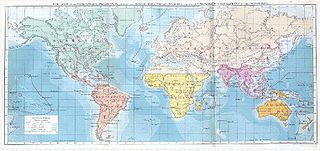
Biogeographic classification of India is the division of India according to biogeographic characteristics. Biogeography is the study of the distribution of species (biology), organisms, and ecosystems in geographic space and through geological time. India has a rich heritage of natural diversity. India ranks fourth in Asia and tenth in the world amongst the top 17 mega-diverse countries in the world. India harbours nearly 11% of the world's floral diversity comprising over 17500 documented flowering plants, 6200 endemic species, 7500 medicinal plants and 246 globally threatened species in only 2.4% of world's land area. India is also home to four biodiversity hotspots—Andaman & Nicobar Islands, Eastern Himalaya, Indo-Burma region, and the Western Ghats. Hence the importance of biogeographical study of India's natural heritage.

The medical ethnobotany of India is the study of Indian medicinal plants and their traditional uses. Plants have been used in the Indian subcontinent for treatment of disease and health maintenance for thousands of years, and remain important staples of health and folk medicine for millions. Indians today utilize plants for both primary medical care and as supplementary treatment alongside modern medical science. It is estimated that 70% of rural Indians use traditional plant based remedies for primary healthcare needs. This reliance of plants for medicine is consistent with trends widely observed in the developing world, where between 65% and 80% of people use medicinal plant remedies.
